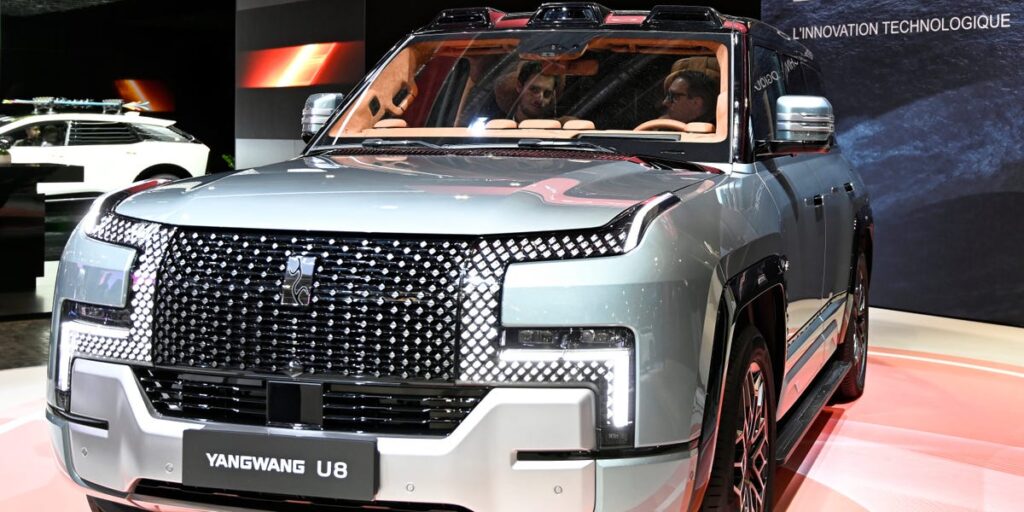- Europe’s luxury carmakers once dominated in China, but are now under intense pressure.
- BMW, Mercedes-Benz, and Porsche have all reported slumping sales in the world’s largest auto market.
- They face rising competition from Chinese carmakers offering cheaper high-tech premium vehicles.
The days of European carmakers dominating China’s luxury vehicle market are over.
Germany’s BMW and Mercedes-Benz have suffered a sales slump in the world’s largest auto market in recent months amid rising pressure from a wave of Chinese EV upstarts.
BMW reported a one-third decline in Chinese sales in the most recent quarter, while deliveries of new Mercedes cars dropped 10% in the first nine months of the year. Its high-end S-Class range was particularly affected as some consumers cut spending amid a faltering economy.
Aston Martin, a luxury British brand famous for its association with James Bond, said sales in China had fallen by more than half this year in its third-quarter earnings.
Meanwhile, Porsche, owned by Volkswagen, said it would shrink its Chinese dealer network amid plunging profits and a 29% slide in sales in China in the nine months to September 30.
The German company has seen stalling demand for its luxury vehicles, with sales of the $100,000 electric Taycan down 47% globally in the same period.
Rolls-Royce, the British marque owned by BMW, has also faced weaker sales in China this year. Its luxury car marker was experiencing “more challenging times,” CEO Chris Brownridge told Bloomberg in September.
The Chinese market has become increasingly difficult for European brands.
Volkswagen was dethroned by BYD as China’s biggest carmaker last year, and the share of China’s car market held by German automakers has dropped from about a quarter before the pandemic to less than 15%, according to Bloomberg data.
“China is an incredible challenge, not just for Porsche,” said finance chief Lutz Meschke in comments reported by Reuters. “In the future, we can no longer assume that China will return to where it was for European players.”
High-tech competition
Upmarket European automakers are being squeezed by their Chinese rivals.
Many are offering vehicles packed full of novel features and intelligent software of them have growing designs on China’s high-end auto market, and are
Last year Tesla rival BYD launched the Yangwang U8 SUV last year. The $150,000 hybrid has a motor on each wheel that allows it to move like a crab.
The U8 also comes with an onboard drone, and BYD says it can even float on water for up to 30 minutes.
Other Chinese automakers have gone to even greater lengths to stand out in the country’s red-hot auto market, with Zeekr showing off the spacious and luxurious interior of its MIX minivan by having an executive eat a hot pot inside it.
The competitiveness of the Chinese market means consumers don’t need to spend a fortune to obtain luxury vehicles.
The SU7, an electric sedan built by Chinese smartphone maker Xiaomi, is packed with high-tech features including a 16.1-inch infotainment screen and remote voice control that allows drivers to control household appliances from the car.
But it is also relatively affordable, with the base version starting at 215,900 yuan ($30,300) and the high-end SU7 Max priced at 299,900 yuan ($42,100). Xiaomi has just unveiled a high-performance version of the SU7 that costs 814,900 yuan ($114,000).
Steve Dyer, managing director at AlixPartners, a London-based consulting firm, told Business Insider that Chinese manufacturers were encroaching on the premium market from the “bottom up,” targeting the lower segment before gradually releasing more expensive vehicles aimed at less price-sensitive customers.
“The Chinese companies are doing what the Korean companies did to get market share outside Korea, and that is to offer a lot of feature content for a good price,” he said.
Dyer said Chinese buyers often focused on luxurious interiors, as well as intelligent technology such as advanced driver assist systems — an area in which Chinese automakers excel and their European rivals have struggled to keep up.
“They’ve fallen behind in the sense that they’re applying an automotive product development mindset to a fast-moving, rapidly changing, technology space,” said Dyer.
A study by AlixPartners found that Chinese automakers released 40 over-the-air software updates between March 2023 and February this year, compared with just two from legacy automakers.
“It’s a typical software mindset. You’re willing to launch a product quickly, even though it may need fixing later because you know you can fix it,” said Dyer.
Hard to quit
Despite a challenging environment, Western premium automakers can ill afford to give up on China. It remains Volkswagen’s second- biggest global market, behind Western Europe, and Mercedes sold around a third of its cars there last year.
They’re likely to face a bumpy road as they try to recover, however.
Because the premium vehicle market is less price-sensitive, Dyer said more Chinese automakers will move into it to diversify away from China’s brutally competitive mass market.
As well as increased competition, European automakers face a geopolitical headache.
Tim Urquhart, principal automotive analyst at S&P Global Mobility, told BI the European Union’s tariffs on Chinese automakers meant Beijing could impose levies on European car imports in retaliation.
“They could be facing a perfect storm if those tariffs are imposed as well,” he said.
Even if that does happen, Urquhart said the sheer size of the Chinese market means it’s unlikely that major Western automakers will abandon it anytime soon. “They can’t afford to make a full-scale retrenchment and retreat from their current position, especially as they’ve invested so much there.”
Read the full article here
















